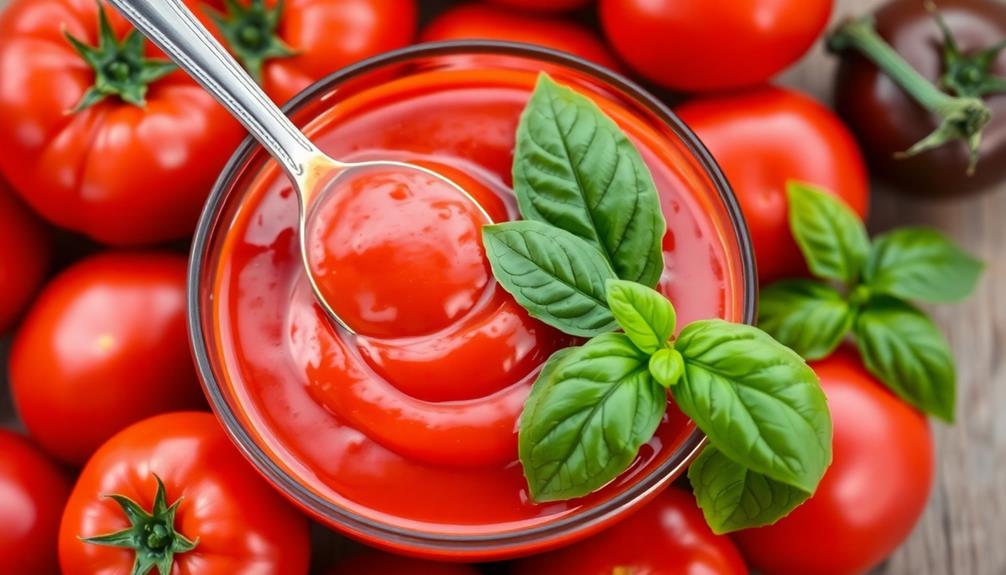Homemade ketchup offers a flavorful and customizable twist on the classic condiment. Its origins date back to ancient China's tangy, fermented fish sauces, later evolving into the tomato-based variety we know today. With fresh, high-quality ingredients, you can create a ketchup that's healthier and more delicious than store-bought. Simmering ripe tomatoes, blending spices, and balancing sweet and tangy notes are the keys to crafting your own signature ketchup. The rewarding process allows you to showcase your culinary skills while inspiring friends and family. And by exploring unexpected flavor combinations, you'll discover the true versatility of this beloved staple.
Key Takeaways
- Homemade ketchup allows for personalized flavor profiles by blending spices, adjusting sweetness and acidity levels, and using high-quality, fresh ingredients.
- The simmering process enhances the depth of flavors in homemade ketchup, creating a richer, more complex taste compared to store-bought varieties.
- Crafting ketchup from scratch showcases culinary skills, fosters a sense of community through shared creations, and inspires others to explore the art of condiment-making.
- Homemade ketchup can be customized to accommodate dietary preferences, such as reducing sugar content, and can be preserved for extended shelf life.
- Exploring unexpected ingredient combinations and the use of fresh herbs can lead to unique and delightful flavor profiles, elevating the classic condiment.
History
The origins of ketchup can be traced back to ancient China, where a fermented fish-based sauce was used as a condiment.
Over time, this savory sauce made its way across the world, evolving into the familiar tomato-based ketchup we know today.
In the 1700s, British sailors brought the concept of ketchup back to Europe, where it quickly gained popularity.
Recipes began to appear in cookbooks, with chefs experimenting with different ingredients like mushrooms, walnuts, and even oysters.
By the 19th century, tomato-based ketchup had become the dominant variety, thanks to the growing availability of this versatile fruit.
The rise of mass-produced ketchup in the late 1800s solidified its place as a classic American condiment.
Companies like Heinz and Hunt's began to bottle and sell ketchup, making it accessible to households across the country.
Today, ketchup remains a beloved staple, with endless opportunities to create your own unique homemade version. Whether it’s adding a touch of heat with some cayenne pepper or experimenting with different sweeteners like honey or maple syrup, the possibilities are endless. Plus, there’s something satisfying about knowing you’ve created a better homemade ketchup that suits your personal taste preferences. So, next time you reach for the store-bought bottle, consider taking the time to craft your own flavorful and unique version instead.
Recipe
Homemade ketchup is a simple yet rewarding project that allows you to control the ingredients and tailor the flavor to your personal preferences. This recipe offers a classic take on the beloved condiment, with a focus on fresh, high-quality ingredients.
The key to delicious homemade ketchup lies in the balance of sweet, tangy, and savory flavors. By simmering ripe tomatoes with a carefully curated blend of spices and seasonings, you'll create a ketchup that far surpasses the store-bought variety in both taste and quality.
Ingredients:
- 3 pounds ripe tomatoes, cored and roughly chopped
- 1 onion, diced
- 2 cloves garlic, minced
- 1/4 cup brown sugar
- 1/4 cup apple cider vinegar
- 2 tablespoons tomato paste
- 1 teaspoon ground cinnamon
- 1/2 teaspoon ground cloves
- 1/2 teaspoon ground allspice
- 1/2 teaspoon salt
- 1/4 teaspoon black pepper
In a large saucepan, combine the chopped tomatoes, onion, and garlic. Bring the mixture to a simmer over medium heat, stirring occasionally, until the tomatoes have released their juices and the onions are translucent, about 15 minutes.
Reduce the heat to low and stir in the brown sugar, apple cider vinegar, tomato paste, cinnamon, cloves, allspice, salt, and pepper. Simmer the mixture, stirring occasionally, for 45 minutes to 1 hour, or until the ketchup has thickened to your desired consistency.
To achieve a smooth, velvety texture, carefully transfer the ketchup to a blender or food processor and blend until desired consistency is reached. Alternatively, you can use an immersion blender to puree the ketchup directly in the saucepan. Be cautious when blending hot liquids.
Once the ketchup is blended, transfer it to sterilized jars or containers and refrigerate for up to 2 weeks.
Cooking Steps
Now it's time to get cooking! First, choose some nice, fresh tomatoes and give them a good rinse.
Next, peel and dice those tomatoes up into small pieces.
Then, let's simmer the tomato mixture on the stove until it gets nice and thick.
After that, you'll need to strain out the tomato skins.
Step 1. Choose and Wash Tomatoes
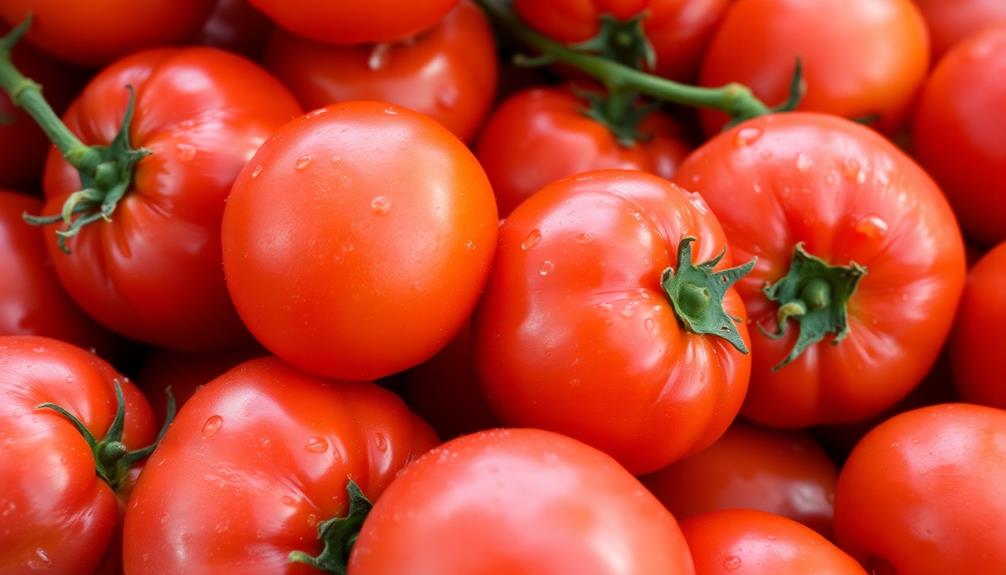
To make the best homemade ketchup, you'll want to choose ripe, juicy tomatoes. Look for tomatoes that are deep red, firm, and free of blemishes.
Avoid tomatoes that are overly soft or have wrinkled skins, as they may not have the right texture for a thick, flavorful ketchup.
Once you've selected your tomatoes, it's time to give them a good wash. Gently rinse the tomatoes under cool running water, being careful not to bruise them. This will remove any dirt or residue on the surface.
You can also use a soft cloth or paper towel to gently pat the tomatoes dry.
Now that your tomatoes are clean and ready to go, you can move on to the next step in the ketchup-making process: chopping and cooking the tomatoes.
This is where the real magic happens, as you transform fresh, juicy tomatoes into a rich, tangy ketchup that will elevate any dish.
Step 2. Peel and Dice Tomatoes
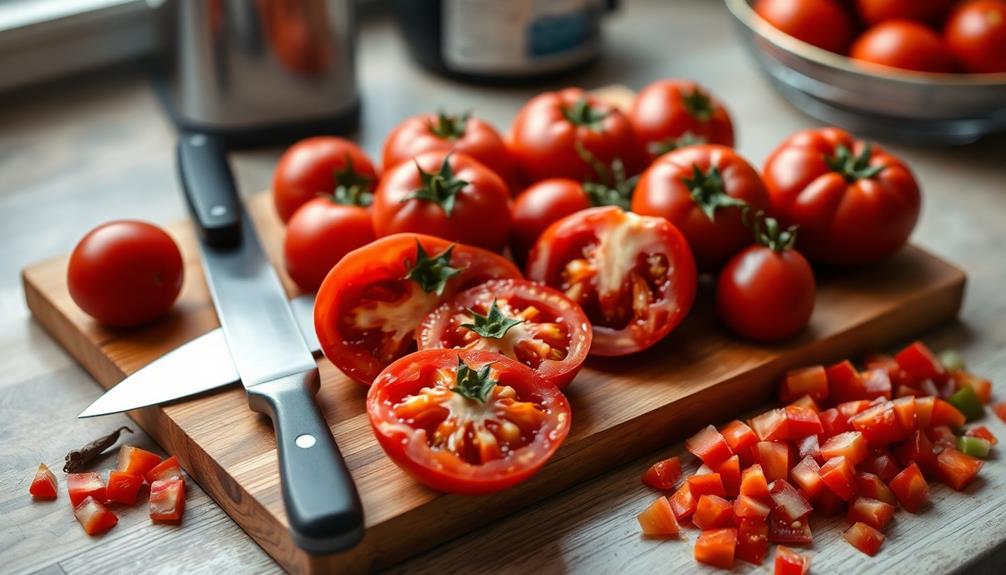
With your freshly washed tomatoes ready, it's time to start preparing them for the cooking process. Grab a sharp knife and cutting board, and let's get to work!
First, you'll need to peel the tomatoes. This may seem daunting, but it's actually quite simple. Gently score an X shape on the bottom of each tomato, then submerge them in boiling water for about 30 seconds. This will loosen the skins, making them easy to peel off with your fingers.
Once the tomatoes are peeled, it's time to dice them. Slice the tomatoes in half, then carefully cut them into small, even cubes. Try to keep the pieces around the same size, so they cook evenly. As you dice, be mindful of your fingers, and take your time to ensure a clean, uniform cut.
With the tomatoes peeled and diced, you're one step closer to creating your delicious homemade ketchup. Now, let's move on to the next step – cooking the tomatoes down into a rich, flavorful purée.
Step 3. Simmer Tomato Mixture Until Thickened
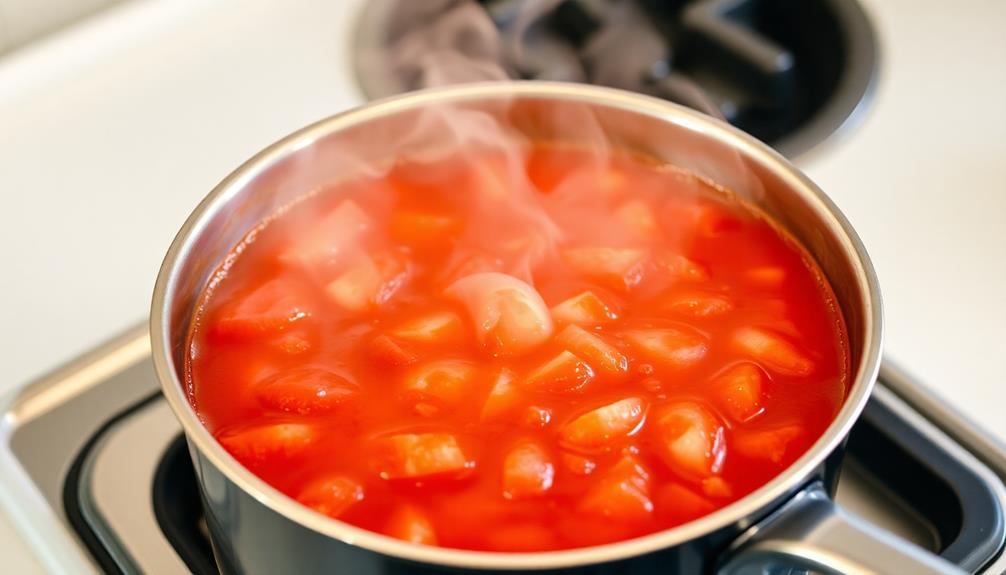
Once the tomatoes are peeled and diced, it's time to start simmering the mixture. Grab a large pot and add the chopped tomatoes, along with any juices that have accumulated. Turn the heat to medium and let the mixture come to a gentle simmer.
It's important to stir the pot occasionally, making sure nothing sticks to the bottom. As the tomatoes cook, they'll start to break down, releasing their natural sugars and creating a rich, flavorful base for your homemade ketchup.
Simmering the tomato mixture is a crucial step in the process. It allows the flavors to meld together and the consistency to thicken up. Depending on the amount of tomatoes you're working with, this step can take anywhere from 30 minutes to an hour.
Keep an eye on the pot, adjusting the heat as needed to maintain a steady simmer. Once the mixture has thickened to your desired consistency, you're ready to move on to the next step in creating your very own batch of delicious, from-scratch ketchup.
Step 4. Strain and Discard Tomato Skins
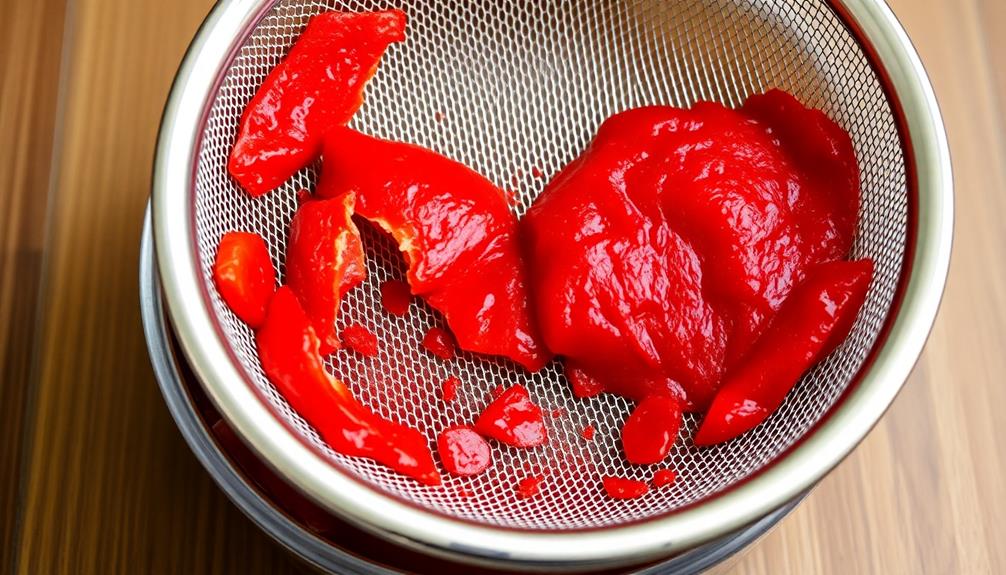
Straining the cooked tomato mixture and discarding the skins is a crucial step in the process. This step helps to create a smooth, velvety texture for your homemade ketchup.
Simply pour the tomato mixture through a fine-mesh strainer, using a spoon to press down on the solids and extract as much of the flavorful liquid as possible. The skins should be left behind in the strainer, so you can toss them out.
Taking the time to strain the mixture ensures your ketchup will have a delightful, uniform consistency. No one likes a chunky, lumpy ketchup, right?
By removing the skins, you're also eliminating any potential bitterness or tough textures that could detract from the overall flavor profile. The smooth, silky ketchup you're left with will be the perfect accompaniment to your favorite foods.
Get ready to take your taste buds on a flavor adventure!
Step 5. Add Seasonings
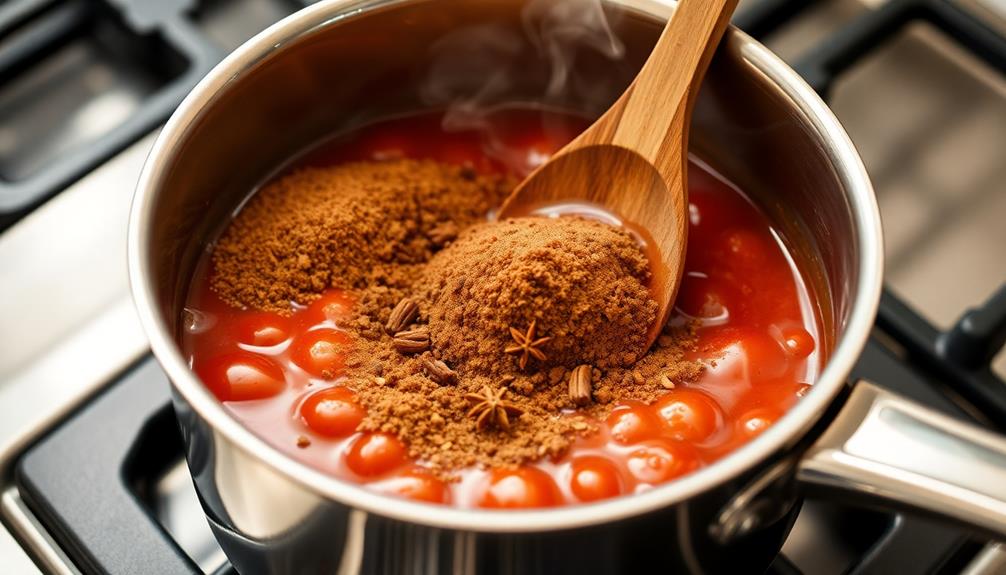
Now that you've strained the tomato mixture, it's time to add the seasonings that will transform your homemade ketchup into a flavor sensation.
In a small bowl, combine 1 teaspoon of garlic powder, 1 teaspoon of onion powder, and 1/2 teaspoon of smoked paprika. These spices will add a savory depth to your ketchup, complementing the sweetness of the tomatoes.
Next, stir in 1 teaspoon of Worcestershire sauce, which will provide a subtle umami note.
Don't forget the classic ketchup flavors – 1/2 teaspoon of ground mustard and 1/4 teaspoon of ground cloves. These spices will add a touch of warmth and complexity to your homemade creation.
Final Thoughts
While making ketchup from scratch may seem daunting, you've now acquired the necessary skills and knowledge to craft your own unique condiment. Celebrate this achievement! You've mastered the art of simmering fresh tomatoes, blending flavorful spices, and striking the perfect balance of sweet, savory, and tangy.
The beauty of homemade ketchup lies in its versatility. Customize the recipe to your taste by experimenting with different herbs and seasonings. Unleash your creativity and make it your own. Whether you prefer a zesty kick or a mellower flavor, the possibilities are endless.
As you savor your homemade ketchup, take pride in the journey. You've elevated a classic condiment, transforming it into something truly special.
Share your culinary triumph with family and friends, and inspire them to embark on their own ketchup-making adventure. The satisfaction of crafting something delicious from scratch is unparalleled. Enjoy every flavorful bite!
Frequently Asked Questions
Can I Use Canned Tomatoes Instead of Fresh?
You can certainly use canned tomatoes instead of fresh ones. Canned tomatoes are a convenient and cost-effective option, and they'll still give you the rich, tangy flavor you're looking for in homemade ketchup.
How Long Does Homemade Ketchup Last in the Fridge?
Homemade ketchup can last up to 3-4 weeks in the fridge if stored properly. The acidity and preservatives help extend its shelf life, but it's best to check for signs of spoilage before using.
Can I Add Different Spices to Change the Flavor?
Absolutely! You can easily customize the flavor of your homemade ketchup by adding different spices. Feel free to experiment with herbs, garlic, onion powder, or even chili peppers to create your own unique taste.
Is It Possible to Make Ketchup Without Sugar?
You can absolutely make ketchup without sugar. Simply omit the sugar from the recipe and focus on the other flavors like tomatoes, vinegar, and spices to create a delicious sugar-free ketchup.
Can I Use This Recipe for Other Condiments Like Barbecue Sauce?
You can certainly use this ketchup recipe as a base for other condiments like barbecue sauce. Simply adjust the spices and seasonings to your desired flavor profile. This versatile recipe can be easily adapted to create a variety of tasty condiments.
